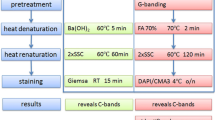Abstract
Analysis of the mouse chromosomes is becoming increasingly important in many fields of genetic research. It is generally considered that the mouse chromosomes are more difficult to analyse than, for example, human chromosomes which has often led to their misidentification. This article presents a guide to the correct identification of trypsin-Giemsa banded chromosomes from the mouse. The variability in the G-banded structure of each chromosome is presented pictorially together with some suggestions for their unequivocal identification. Since many of the mouse chromosomes have similar banding patterns, those chromosomes which are more frequently misidentified have been compared and contrasted. Finally a summary of the main features for the identification of each chromosome is presented.
Similar content being viewed by others
References
Buckland RA, Evans HJ, Sumner AT (1971) Identifying mouse chromosomes with the ASG technique. Exp Cell Res 69:231–236
Committee on Standardised Genetic Nomenclature for Mice (1972) Standard karyotype of the mouse, Mus musculus. J Hered 63:69–72
Cowell JK (1979) Chromosomal changes associated with epithelial cell transformation with special reference to in vitro systems. In: Franks LM, Wigley CB (eds) Neoplastic transformation in differentiated epithelial cell systems in vitro. Academic Press, London, pp 259–286
Cowell JK (1980a) A new chromosome region possibly derived from double minutes in an in vitro transformed epithelial cell line. Cytogenet Cell Genet 27:2–7
Cowell JK (1980b) Consistent chromosome abnormalities associated with mouse bladder epithelial cell lines transformed in vitro. J Natl Cancer Inst 65:955–961
Cowell JK (1981) Chromosome abnormalities associated with salivary gland epithelial cell lines transformed in vitro and in vivo with evidence of a role for genetic imbalance. Cancer Res 41:1508–1517
Cowell JK (1982a) Appearance of double minute chromosomes in somatic cell hybridisation experiments involving the HAT selection system. Cell Biol Int Rep 6:393–399
Cowell JK (1982b) Double minutes and homogeneously staining regions: gene amplification in mammalian cells. Ann Rev Genet 16:21–59
Cowell JK, Wigley CB (1982) Chromosomal changes associated with the progression of cell lines from a preneoplastic to a tumorigenic phenotype during transformation of mouse salivary gland epithelium in vitro. J Natl Cancer Inst 69:425–433
Dofuku R, Utakoji T, Matuzawa A (1979) Trisomy of chromosome 13 in spontaneous mammary tumors of GR, C3H and non-inbred Swiss mice. J Natl Cancer Inst 63:651–656
ISCN (1978) An international system for human cytogenetic nomenclature. Birth defects: Original article series Vol XIV, No. 8 (The National Foundation, New York 1978); also in Cytogenet Cell Genet 21: 309–404
Miller OJ, Miller DA, Kuori RE, Allerdice PN, Dev VG, Grewal MS, Hutton JJ (1971) Identification of the mouse karyotype by quinacrine fluorescence and tentative assignment of seven linkage groups. Proc Natl Acad Sci USA 68:1530–1533
Miller DA, Miller OJ (1981) In: The mouse in biomedical research Vol 1, Academic Press, New York, pp 241–261
Miller DA, Miller OJ (1983) Chromosomes and Cancer in the mouse: Studies in tumours, established cell lines and cell hybrids. Adv Cancer Res 39:152–182
Nesbitt MN, Francke U (1973) A system of nomenclature for band patterns of mouse chromosomes. Chromosoma 41:145–158
Schnedl W (1971) The karyotype of the mouse. Chromosoma 35:111–116
Spira J (1980) Response to reference Dofuku et al. 1979. J Natl Cancer Inst 65:688
Yunis JJ (1981) Mid-prophase chromosomes; the attainment of 2000 bands. Human Genet 41:145–158
Author information
Authors and Affiliations
Rights and permissions
About this article
Cite this article
Cowell, J.K. A photographic representation of the variability in the G-banded structure of the chromosomes in the mouse karyotype. Chromosoma 89, 294–320 (1984). https://doi.org/10.1007/BF00292478
Received:
Revised:
Issue Date:
DOI: https://doi.org/10.1007/BF00292478




